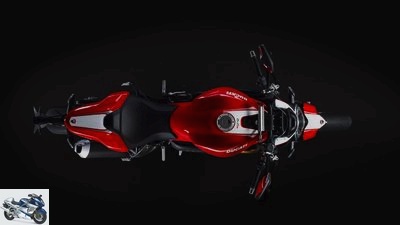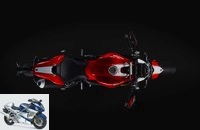Menus

Ducati
Ducati innovations 2016
New Monster 1200 R and Diavel
The new Ducati Monster 1200 R is the most powerful thing that ever appeared under this label. 160 PS, with a full tank of 207 kilograms – these are breathtaking values for a once well-behaved naked bike.
E.First of all: A strip by Supersport sister Panigale was never on the agenda in Bologna, even if many would like it. And it wouldn’t have made any sense either. “The Panigale engine is an uncompromising engine with the corresponding power delivery,” explains Gianluca Zattoni, who is also responsible for the Monster R engine. And the benchmark of 160 PS was reached that way – with the Testastretta drive. In addition, according to Marketing Manager Paolo Quattrino, the Panigale is difficult to strip. One would like to believe in view of the ultra-compact powerhouse. Technology would have come to light in a confined space.
Buy complete article

Ducati innovations 2016
New Monster 1200 R and Diavel
Ducati in the vehicle documents usually indicates less power than in the advertising, the Monster will have around 152 hp there.
On the test bench, however, the reds from Bologna often deliver more power than stated, so that measured 155 hp should be realistic, while BMW and KTM each deliver real 168 hp. A mishap? Perhaps on the racetrack, but certainly not in everyday life. Especially not when the chassis works as well as on the civilian Monster S. Ohlins spring elements (with black instead of gold stanchions) are also used on the R, but now combined with the lightweight Panigale forged wheels and their Brembo M50 Monoblock brake calipers including huge 330 millimeter brake discs.
In addition, new, super sporty Pirelli Supercorsa SP have been raised instead of the Diablo Rosso II used on the Monster S. In the back, of course, in 200 format. “Ready for the Track” is what they call it in Bologna. And, given the extensive assistance package, he is probably not entirely wrong. In summary, the electronic helpers operate under the name Ducati Safety Pack (DSP). What is meant is the latest generation of Bosch 9MP ABS in combination with traction control (DTC) and three different injection modes that vary the power output and engine response.
The “Sport”, “Touring” and “Urban” modes are set at the factory, and everything is influenced by the throttle response, the intervention of the traction control and the ABS control behavior through to the lift-up prevention of the rear wheel. These modes can also be changed easily while driving, while the user-defined setting (here you can choose between three ABS and eight traction control settings) can only be changed when the vehicle is stationary.
Purists and traditionalists are turning away with horror in the face of this flood of electronics. However, you should note that both ABS and DTC can be switched off – and remain switched off after a restart. Only the option, which is very important for wheelie fans, of being able to deactivate wheelie control while driving at the push of a button, is missing in the electronics exit scenario. Finish line acrobatics suitable for cameras or inner-city rutting behavior will therefore be more common. Apart from that, the wheelie control should be very welcome given 131 Newton meters of torque and only 207 kg with a full tank.
On the weight: two kilograms have been saved compared to the S version, and this is largely due to the lighter wheels and the slimmer, three centimeters shorter and redesigned rear frame. Not much, one might think, but Euro 4 does not make things any easier for the engineers, because many weight-increasing modifications (some of which even affect the frame) are necessary. In addition, there is a chassis that is 20 millimeters higher with a longer fork and longer shock absorber, but the suspension travel remains unchanged (130/159 millimeters). The seat height has increased to 830 instead of the previous 810 millimeters, the lean angle accordingly, especially since the milled aluminum notches are now shorter.
The basic ergonomic conditions, however, have remained the same. At least for the driver, while the backbencher has to make compromises in view of the sporting orientation. Its footrests are now on their own outriggers, the passenger grab handles have been completely painted. In return, the usual goodies are of course delivered, which make a top version a top version. Forged aluminum footrest bracket, carbon fenders, mini fairing, sandblasted radiator covers, a bench with an R emblem, the multifunctional TFT four-color display – the Monster R is not like poor people. As well as? The most expensive monster to date, the 1200 S Stripe, already costs 17,250 euros. The R will of course be higher than this, an exact price has not yet been determined. The R will be available at dealers in early January. In red and black.
Technical specifications
Two-cylinder 90-degree V-engine, 1198 cm³, 117.7 kW (160 PS) at 9250 / min, 131 Nm at 7750 / min, tubular steel frame, upside-down fork, Ø 48 mm, single-sided swing arm made of aluminum , Double disc brake front, Ø 330 mm, disc brake rear, Ø 245 mm, ABS, traction control, tires 120/70 ZR 17 and 200/55 ZR 17, wheelbase 1509 mm, spring travel front / rear 130/159 mm, seat height 830 mm, tank capacity 17.5 liters, dry weight 180 kg, price k. A..
New Diavel with toothed belt
Ducati is working on all fronts, and in 2016 it will present a flurry of new and revised models. One of them is the new Diavel, which our Erlkonigjager recently drove in front of the lens (see pictures on the right). As it looks, nothing stayed the same with the new Diavel apart from the unique alignment somewhere between athlete and chopper and the exciting Testastretta engine (but now with DVT, i.e. variable timing) with only eleven degrees of valve overlap.
The Diavel is getting slimmer and sportier – this is how designer Kar Lee sees it in his computer retouching below. And it gets – the most striking technical innovation – as a secondary drive a toothed belt instead of the previous drive chain. The mighty rear wheel with its attractive spoke design is guided by a completely new, mighty single-sided swing arm, to which the license plate holder is attached – just as before.
The high rear towers above it at a good distance, and thanks to the new rear light design and filigree rear cover, it now looks much sharper than the previous Pummel solution. Also brand new is the exhaust, the final design of which initially leaves room for fantasy. What is clear, however, is that the curved manifold guide is a thing of the past. Instead, there is now a central front silencer in front of the rear wheel, which in turn enables the footrest position to be moved further forward.
Also new – and more straightforward, because the bend of the rear cylinder is no longer in the way: the tubular space frame, on which a less round tank sits enthroned, the lines of which appear much more swift. An attribute that basically applies to the entire front end. The headlight in particular differs significantly from the previous round component. And what does Ducati say about the new bike? Nothing. No comment!
Related articles
-
Ducati innovations at INTERMOT 2016
fact 14 pictures Ducati 1/14 Ducati 1299 Panigale S at INTERMOT 2016. Ducati 2/14 Ducati Diavel at INTERMOT 2016. Ducati 3/14 Ducati Monster 821 …
-
Ducati Model presentation: Ducati Well mixed She was one of the stars of INTERMOT, the new Scrambler. Because it does perfectly what others struggle…
-
New motorcycle products: Ducati Diavel (with video)
Ducati 10 pictures Ducati 1/10 Ducati Diavel Carbon: The Italians officially presented their Power Cruiser at the Eicma. The Testastretta 11 ° engine …
-
Ducati Monster 1200 S in the driving report
Ducati 47 photos Ducati 1/47 Ducati 2/47 Ducati 3/47 Ducati 4/47 Ducati 5/47 Ducati 6/47 Ducati 7/47 Ducati 8/47 Ducati 9/47 Ducati 10/47 Ducati 11/47…
-
Ducati 1199 Panigale S – The new super sports car
Ducati Driving report: Ducati 1199 Panigale S The new super sports car from Ducati Your task is clearly defined: be fast on the racetrack. For this…
-
Comparison test KTM 990 Supermoto versus Ducati Hypermotard 1100
Mayer Comparison test KTM 990 Supermoto versus Ducati Hypermotard 1100 Supermoto duel Sharp edges or curved lines: with the Hypermotard 1100 and the 990…
-
BMW Model presentation: BMW Triple pack from BMW BMW will present five new models this autumn, three of which were on display at the Intermot in Cologne…
-
Ducati innovations 2021: Italians with a five-step plan
New items 2021 New motorcycle items 2021 Ducati 45 pictures Ducati 1/45 Ducati brings the new Multistrada with V4 engine. Ducati 2/45 Ducati has the …
-
Ducati innovations, Ducati Monster 1100, Ducati Monster 696, Ducati Multistrada 1200 Ducati innovations 2010 Hardly any motorcycle manufacturer puts such pressure on the …
-
Innovations: Erlkonig Ducati Scrambler
BMH-Images, Bernhard M. Hoehne News: The Paparazzo Mr. Piëch’s Bike +++ New Scrambler is Ferdinand Piëch’s dream motorcycle +++ Basic Ducati …